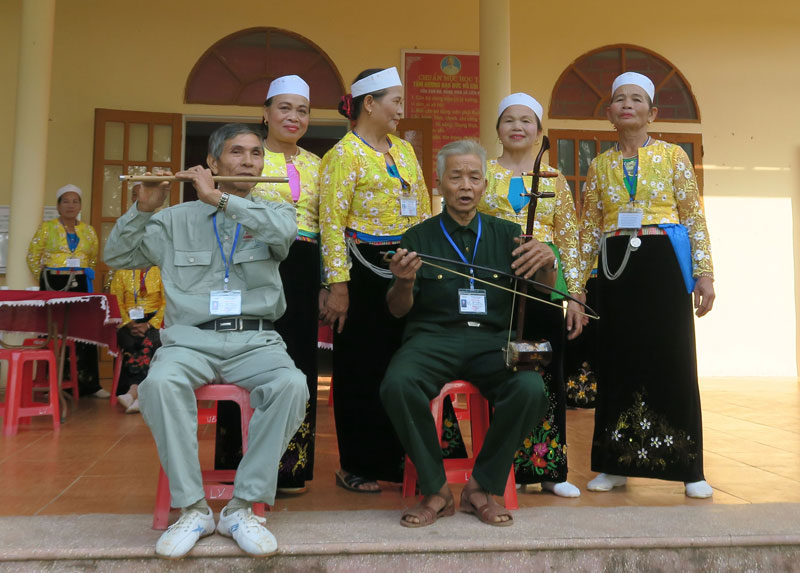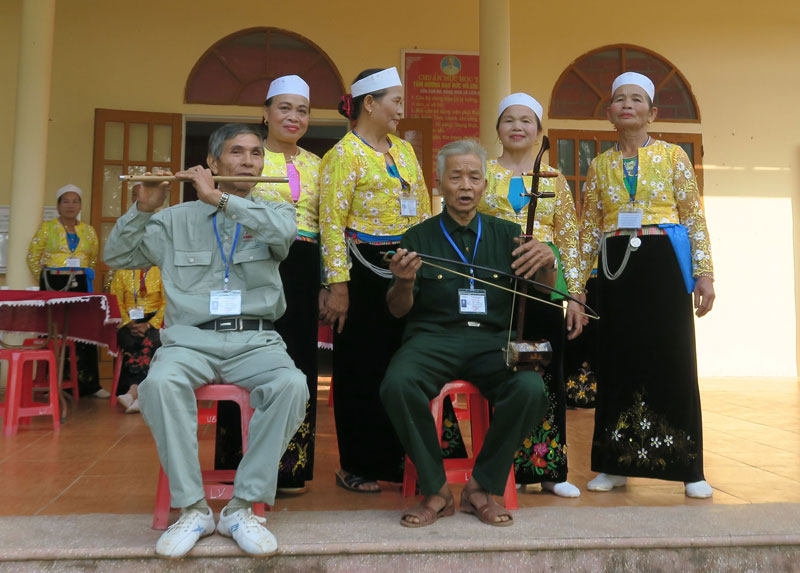
(HBO) - Being present in the exchange between the poetry club "Remembering the Source” of Lac Son district and the members of the Literature Association (the provincial Literature and Culture Association), I immersed myself in Senh Tien and Luu Thuy dances, dancing with flowers and I was completely absorbed in Muong folk songs.
 The members of the poetry club "Remembering the Source” (Lac
Son) are practicing before the show.
The members of the poetry club "Remembering the Source” (Lac
Son) are practicing before the show.
Ms. Bui Thi My in Chay hamlet, an active nucleus of the club
shares: The poetry club "Remembering the Source” is a rendezvous for the
culture and art lovers of Huong Nhuong and Lien Vu (former) communes. Seeing
the need for a playground to exchange, to share, to sing and to dance for each
other and to promote the national cultural identity, in 2012 more than a dozen
people gathered together to set up a poetry club called "Remembering the source”.
Immediately it has maintained for 8 years, currently there are 25 members aged
60-76.
Since its foundation, the club has been maintaining the
regular activities every Saturday night or Sunday. Sometimes they perform in
the local festivals. Most of the poems and music are composed and performed by
the members of the club. Only when there is a large-scale and highly artistic
program to perform for the diplomatic exchange, they need the assistance from
the officials of the Center for Culture, Sports and Tourism of the district.
At present, the club "Remembering the Source” has affirmed
its "brand” with the repertoire bearing the cultural characteristics of Muong
Vang: "Playing the gongs”, singing and dancing "The Festival of Muong area”,
"The Brocade craft village”, "Lac Son in the festival night”, "The flavor of
Muong”, "The Song of the Northwest”... and Dum songs, sweet and deep folk songs
of Muong. In spite of the fact that they
are only home-grown, the singing and the dances of the Club "Remembering the
Source” has reached out to many other districts such as Kim Boi, Lac Thuy, Yen
Thuy and Hoa Binh City and even to Hanoi Capital.
Participating in the exchange, the members of the Literature
Association have brought the poems and songs that imbued with Muong cultural
identity. They are "The Forest music”, "The advice of a friend from highland
area”, "Don't do that, please!”, "The Words from Muong Area”, "The love story
of Tay Tien soldiers”, the song "Muong Vo Rice, Muong Vang Jar” and so on.
Many people have heard and watched the members of the poetry
club "Remember the Source” performing, or know that they are actively guiding
and teaching the way to play the gong, to pull stamen and to sing the folk
songs of Muong for the younger generation, they all show their confession. As
they are contributing to keeping the soul of Muong in every song, dance with
enthusiasm, passion.
With an increasingly vibrant and widespread emulation movement aimed at building cultured residential areas and cultured families, Yen Thuy District has been making steady progress toward improving both the material and spiritual well-being of its people, while fostering a civilized, prosperous, beautiful, and progressive community.
Once lacking recreational spaces and community facilities, Residential Group 2 in Quynh Lam Ward (Hoa Binh City) has recently received attention for the construction of a new, spacious, and fully equipped cultural house. The project followed the model of state support combined with public contributions in both labor and funding.
The "All people unite to build cultural life" movement, which has been effectively integrated with Kim Boi district’s socio-economic development goals, is fostering a lively spirit of emulation across local residential areas, hamlets, villages, public agencies, and enterprises. In addition, through the initiative, traditional cultural values are being preserved and promoted, while community solidarity and mutual support in poverty reduction and economic development are being strengthened.
A working delegation of the Hoa Binh provincial People’s Committee led by its Permanent Vice Chairman Nguyen Van Toan on June 11 inspected the progress of a project to build the Mo Muong Cultural Heritage Conservation Space linked to tourism services in Hop Phong commune, Cao Phong district.
Born and growing in the heroic land of Muong Dong, Dinh Thi Kieu Dung, a resident in Bo town of Kim Boi district, in her childhood was nurtured by the sweet lullabies of her grandmother and mother. These melodies deeply imprinted on her soul, becoming an inseparable part of her love for her ethnic group's culture. For over 20 years, this love for her hometown has driven Dung to research, collect, and pass down the cultural values of the Muong people to future generations.
In the final days of May, the Ethnic Art Troupe of Hoa Binh Province organized performances to serve the people in remote, mountainous, and particularly disadvantaged areas within the province. These were not just ordinary artistic shows, but they were the meaningful journeys aimed at spreading cultural values, enhancing the spiritual life of the people and contributing to the preservation of ethnic minority cultural identities.



 The members of the poetry club "Remembering the Source” (Lac
Son) are practicing before the show.
The members of the poetry club "Remembering the Source” (Lac
Son) are practicing before the show.